At the start of 2012 I added three new cameras: Canon 5D Mark III, Canon G1 X w/housing, GoPro Hero2. I also added a new lens, a Rokinon 24mm f/1.4. The 5D III’s improved autofocus gave me more bird photography keepers; the G1 X, a magazine cover shot (Sea Kayaker, Dec. 2012). The GoPro—a POV videocam—has been fun, but I’m still figuring out how to make use of it. The Rokinon was purchased for night photography; I didn’t get the killer Milky Way shot I was seeking.
I hit the trails backpacking more this year, hiking farther with a lighter pack. I hiked or kayaked to some dazzling new locations. My photography was confined to Washington and Oregon. Bird photography was aided by playing bird song with my iPod.
As in past years, I relied on Photoshop Lightroom and Elements. Significant manipulation produced some of my favorite images. I enjoy digital manipulation—Photoshop is a creative challenge on its own—but if images are altered beyond routine spot removal, or moderate temperature, saturation and contrast adjustment, declaring them “digitally altered” or “digital composite” is, or should be, the rule.
Selecting a dozen favorites went quickly using a Lightroom Collection and the dates and ratings within the Lightroom filter. Please enjoy the selects and the accompanying explanations.
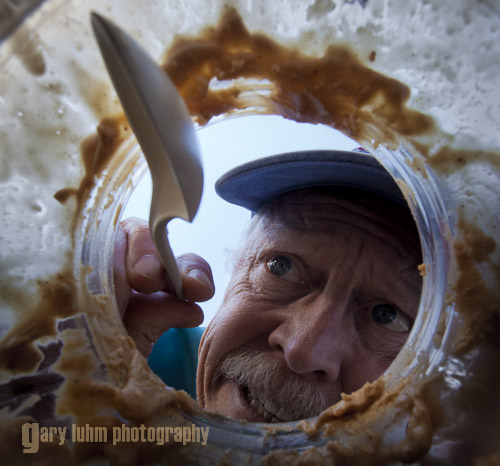
Peanut Butter
I owe this one to John Greengo, inspired by his presentation, “The Photographic Eye” (Kenmore Camera Expo, Nov, 2011). John’s Powerpoint and teaching skills puts his presentations in a class by themselves—motivating, inspiring stuff.
Greengo was on a canoe trip in Canada years ago and he and his paddling partner ran out of food. He wanted to express this photographically, and he hit upon the idea of an empty peanut butter jar point-of-view, with him holding a knife looking in. I got LOL about that, and created my own version. I used an empty Adam’s peanut butter jar. I set up a simple, outdoor shot, and tried for a facial expression that says desperate. The image at left is the one I liked best. I thought I might have something when my wife worried out loud what the relatives would think! Thanks again to Greengo for the inspiration.
I’ll leave it to you to figure out how I got my camera inside the jar.
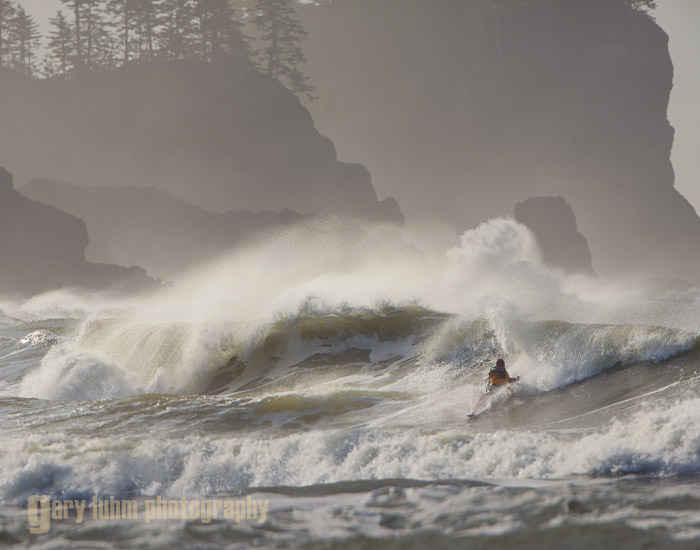
La Push
Huge, confused, 23 ft seas roiled sea stacks and beach to begin the February, 2012, annual Kayak Pummel at La Push, WA. Kayakers went hiking instead of surfing, or drove to Crescent Beach on the Strait of Juan de Fuca for tamer water. By Sunday, the swell dropped to 8 or 10 feet. Kayak surfer Sean Watson ventured out, catching a few waves in a still messy sea. I photographed with long lens and tripod while standing on the beach, trying as I always do to line up distant sea stacks with the action on the waves. The best background is usually the knife-like Needles, but this day I thought the inshore mist made the cliffs and stacks of First and Second Beach the best bet. I tried placing Sean beneath them, but it proved too big a challenge. By the time he passed in front of the cliffs, the wave energy had dissolved into foam, no matter where I positioned myself on the beach.
In the end I shot a separate image of crashing waves beneath the distant stacks, and in Photoshop merged it with one of Sean surfing a high-energy wave. The image will soon be published in Adventure Kayak magazine. As always, integrity demands that images like this be disclosed as digital composites.
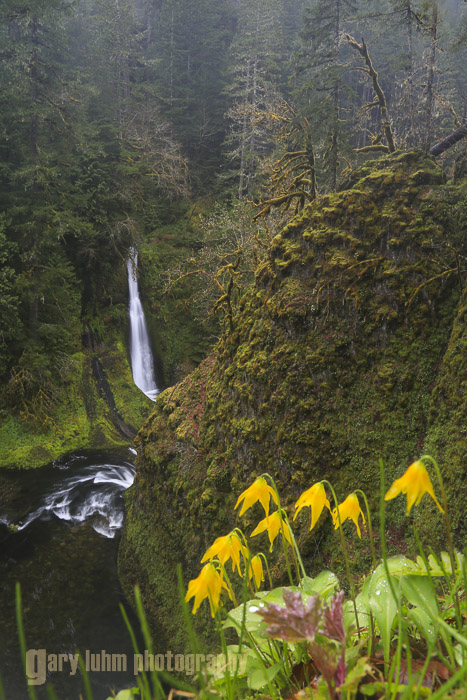
Fawn Lilies
In April I backpacked Eagle Creek in the Columbia Gorge, Oregon, and camped about a mile short of Tunnel Falls. Spring in the Gorge is glorious, a visual feast of green and black. On this trip it was wet green and black, raining continuously through the hike in, through the night and through much of the next day. Regardless, the hike was heavenly: fresh spring growth, full-volume waterfalls and lovely early wildflowers. I did all my shooting with a 24-105 f/4 lens, accompanied by a polarizing filter that demolished glare and enhanced color saturation. I shot on a tripod, protecting the camera with a shower cap when not in use. A surprise bonus of the hike was the Fawn Lilies that lined the trail.
Just below High Bridge, I captured this image of Loowit Falls with a Fawn Lily foreground. I got low to raise the Lilies up a bit against the distant cliffs. I used a focus stack technique, shooting first at f/16 focused on the foreground Lilies, and second at f/11 focused on the background. I might have gotten it all in focus at f/22, but the resolution loss from diffraction at f/22 is large. The two images were merged manually in Photoshop Elements 10.
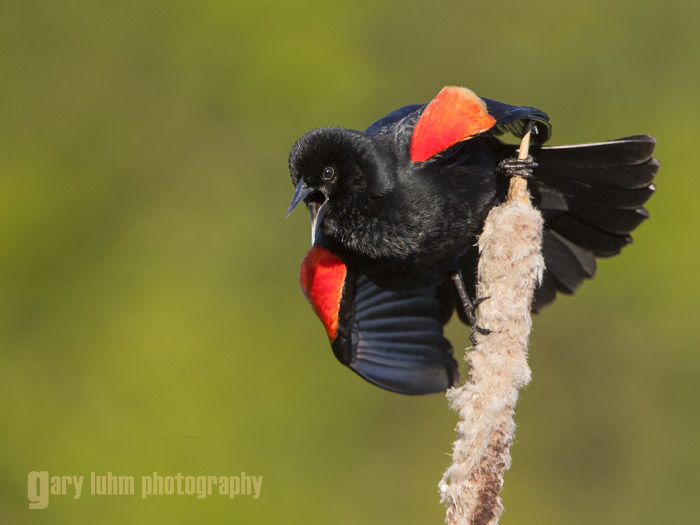
Red-winged Blackbird
For years I’ve gone after displaying Red-winged Blackbirds at Juanita Bay Park, not far from my home in Kirkland, WA. I never got the shot I envisioned, but those alluring red epaulets kept me in the chase. At Juanita Bay it’s easy to see display behavior at any of several boardwalks that jut out into the Bay. Armed this year with an iPod to attract the bird with song, I still mangled every opportunity.
At the time I was also shooting from my kayak a lot, handholding a 500mm f/4 or sometimes resting the big lens on a deck bag. One spring morning I paddled into a slough in Yarrow Bay on Lake Washington. As I glided toward a clump of cattail, a Blackbird leaped near and displayed. I dropped the paddle, and lifted and fired the 500mm. I caught the peak action, and the background was perfect. The quick autofocus of the Canon 5D Mark III certainly helped, getting fast on the bird and nailing the focus. It didn’t hurt that I was shooting quite a bit from the kayak that month, honing the skills needed to nail this type of shot.
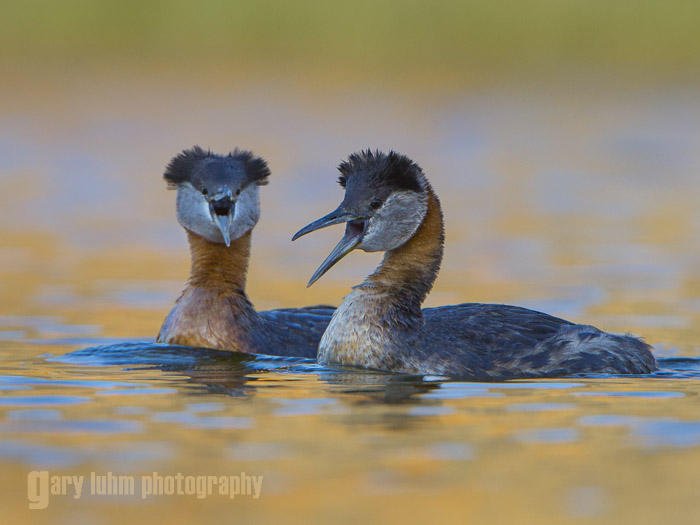
Redneck
In early May I discovered four pairs of Red-necked Grebe and three of their floating nests while kayaking shoreline at an Eastern Washington lake. The Grebes were skittish, and if a bird was on the nest as I paddle by it was likely to hop off and swim away before I got near. This was an exploratory paddle—like many outings, a scouting mission. The eggs that I could see looked newly-laid white.
Red-necked Grebes sit on eggs about 25 days before hatching. As with other Grebes, the eggs hatch asynchronously; different ages of chicks are common. The chicks climb aboard the parents backs right away for warmth and protection, and remain aboard much of the time for up to two weeks. Wouldn’t it be great to capture these gorgeous birds with tiny chicks on the parent’s backs?
The day after Memorial Day, hoping for flotillas of Grebe families, I returned. On a quick paddle around the lake, though, I found all the nests empty or destroyed. Since it was just a day after Memorial Day, I surmised that the throng of weekend boaters on the lake may have disturbed the more vulnerable nests. The others, farther from the boat launch and more protected, may have succumbed to predation—by raven, raccoon, otter, possibly carp. It’s also possible that wind was a factor. The Grebes were all still in their territories—rebuilding, copulating and laying fresh eggs. I found four nests; I saw a single fresh egg in one of them. One Grebe nest was again close to the boat launch. In the late afternoon I launched a kayak and floated out in the channel. I played my iPod, which brought out the Grebes to confront an invisible intruder, and I got a few shots. Then the sun disappeared behind a western cliff, and I retreated to the launch. Before going ashore, I saw the reflected orange hues of a distant cliff in shaded water—a lovely backdrop. I played the iPod one more time, and the Grebes responded, approaching me together, enveloped by the exquisite reflections from the rock cliffs behind.
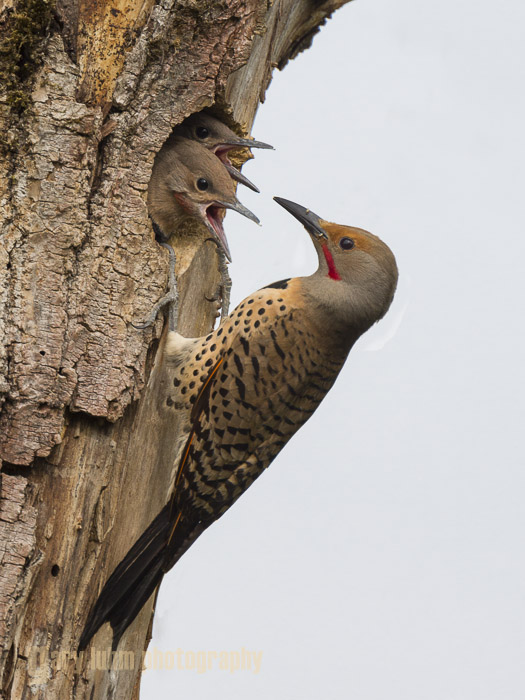
Flicker Nest
In spring I look almost daily for bird nests. This year I targeted woodpeckers especially. Finding woodpecker nests isn’t difficult; finding nests that will make good photographs is a challenge. Of woodpeckers, the Flicker is probably the toughest to photograph. Their nests are often in deep woods, and high up in old snags. Most compounding for photographers, even in urban settings Flickers are wary birds, so skittish they won’t fly to the nest if you’re nearby, and they’re likely to not tolerate a blind.
This year in one of the places I monitor, a Flicker pair established a nest just a dozen or so feet above the ground, and fairly easy to photograph from a couple of clear angles. Fearing the usual Flicker intolerance, I avoided the area for weeks, finally returning only with binoculars when I thought the parent birds would be invested in their brood, and more likely to abide a brief disturbance. With me standing nearby (∼ 60 ft), the male parent came in regularly with food. The female never came in, which was troublesome, though I did see her. Once she did a flyby but didn’t land at the nest, and once she was feeding or collecting ants on the ground, perhaps 100 feet from where I stood. I decided if I came to photograph, my visits would be short.
At this point the chicks were sticking their heads out the nesthole—always when the male came in with food, and sometimes between feedings. The chicks were a few days or a week from fledging. I waited for decent light. When it arrived, I photographed the nest on one morning, and two evenings, each time for no more than an hour. I used a tall stepladder to put me at a nearly level plane, using a 500mm f/4 with 1.4x tele-extender. I was as close as 11 meters (36 ft), according to metadata. As before, only the male flew in while I photographed. The light the first evening was bright overcast, and I think I got my best shot. The second evening I had a blue sky, and warm, over-the-shoulder evening light; my image results were good but not better. After that I didn’t return; the chicks probably fledged a day or so later.
I felt ok photographing this particular nest, but I did worry about it. Especially in an urban setting, other photographers may find and photograph the nest as well. When would it just be too much? Bird nest photography is a risky endeavor. The more knowledge you have, the better able you may be at judging potential harm caused by intrusions. It can be a difficult call.

Minus Tide
In July I paddled once again to Point of Arches on the Olympic Coast, hoping to capture the fabled sunset. And just like last year, the sunsets were a bust—brooding overcast one night, cloudless with little color the next. I timed my visit for morning minus tides, though, and the tidepooling didn’t disappoint. Always in tidepools, new discoveries, permutations and patterns rule. Always there is the fetid intertidal air, invertebrates eating invertebrates, a surprised raccoon or otter. When I entered the cathedral of sea stacks the first morning, a pair of Peregine Falcons dive-bombed a Bald Eagle overhead. I watched them long enough to discover both had nearby nests atop the sea stacks.
When skies are gray, my outdoor photography rule is “eliminate the sky”. I got rid of most of it in this photo, a focus stack of two images plus a third, underexposed image to manage the bright sky in the archway. I shot the foreground at f/16, and two for the background at f/11. I like the S-curve of sea stars and anemone, as well as the smooth curve of sand that invites barefoot exploration back to the archway and beyond. The archway itself adds some mystery. The dark rock around it acts like a container, keeping the eye from wandering.
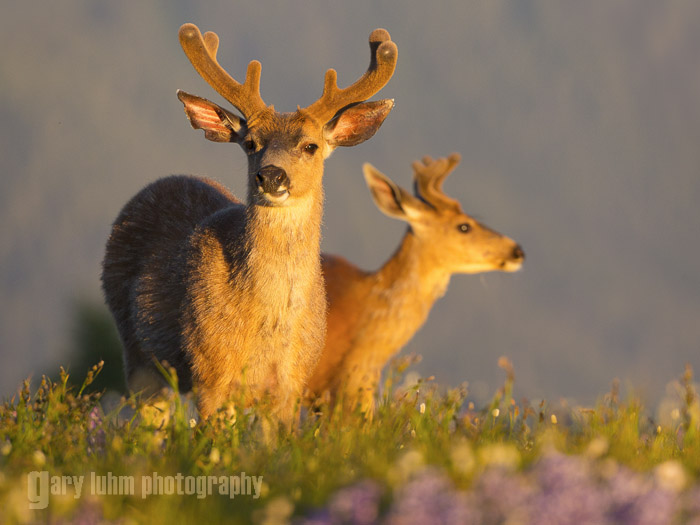
Blacktail Buck
Also in July, the following week I was at Hurricane Ridge in Olympic National Park, for a sunlit, evening shoot. The aroma of Lupine wafted over the meadow; fawns scampered about. As shadows grew long in the warm sun, a pair of bucks in velvet stole the evening show. They traversed the meadow, browsing, facing into the sun. I grabbed my camera, and with the 500mm f/4 fixed on a tripod, positioned myself along the asphalt pathway, up-sun of the bucks. I set up low, fired off some images, then moved quickly to keep the sun as close as I could to “over the shoulder”. I was running out of asphalt when the bucks paused together long enough for me to capture a good series. Still, I didn’t get both bucks in a frame with both their heads raised.
To create this image, then, required Photoshop. I selected the images that had a raised head from each buck. The deer were otherwise closely aligned, so combining them with a layer mask was routine. Additionally, though the light was warm, I warmed it even more in Lightroom, pushing the temperature slider to 5800 (from an Auto 5200). I suppose I could have pushed it to 7000, for a more surreal alpenglow. Largely, that’s a matter of taste.
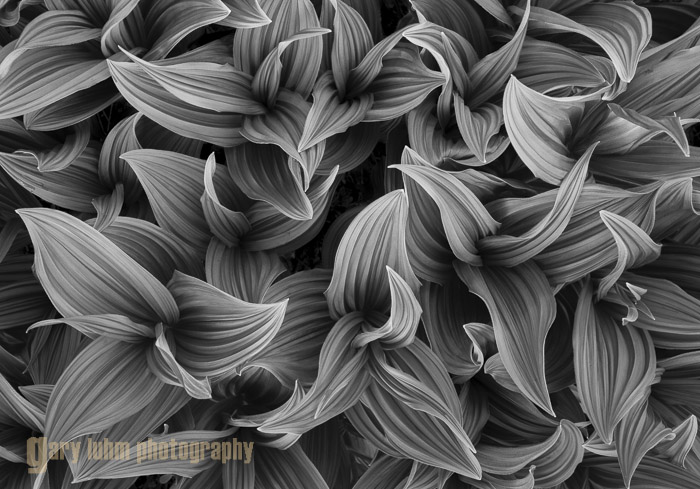
Hellebore Pattern in Black and White
In August, I backpacked for the first time in Washington State’s Goat Rocks Wilderness. Goat Rocks is a place of worn volcanic spires, wildflower meadows and glorious, ridgetop hiking—a place for the bucket list. Unfortunately, in this heavy snow year, our August trip was too early for the higher trails, too early for the big flower bloom. We encountered snow on the trail well before reaching 5,800 foot Snowgrass Flats. At our first camp in Cispus Basin, the snow had just melted out. On our second and third days, higher up toward Goat Lake, we lost the trail several times due to snow. Goat Lake itself was frozen and snow-covered. Few wildflowers bloomed, but it was pleasing to see Glacier Lilies poking through snow. Cispus Basin—less snowbound than Snowgrass—had blooming Pasque Flower and Marsh Marigold in wet areas, and Lupine, Arnica and Cat’s Ear in places more snow free. Trailside False Hellebore were emerging.
I captured this engaging Hellebore pattern with a quick setup of the tripod, looking down on the twirling leaves. The lush greens popped with the polarizing filter, but I like the black and white. It better captures the rhythm; I thought the color a distraction.
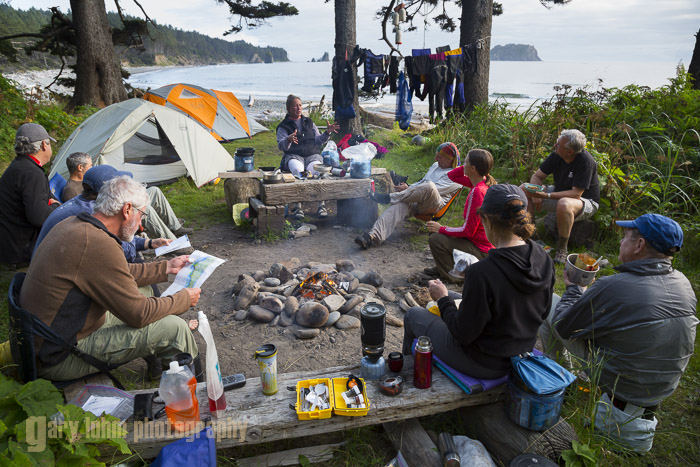
The Tribe Makes Camp
The next week I joined a Washington Kayak Club trip on the Olympic Coast, paddling from La Push to Makah Bay with a car shuttle return. I was thrilled to paddle here, and, as many times as I have paddled the coast, the stretch from La Push all the way north to Ozette would be new. Our first camp was Cedar Creek. On the way we passed Jagged Island (in the distance in the photo), summer home to 4,000 Tufted Puffins; nearby on the water we saw probably the second largest summer sea otter gathering on the Washington Coast. The Cedar Creek camp is the best: a semi-protected landing, campsites off the sand beach but well lit, expansive views of the Pacific.
This image was little more than a grab shot. I framed it to include just a bit of sea, the distant sea stack and sky, and I made sure I got everyone in. I love all the activity, the warm campfire, clothes hung out to dry. We’re escaping city life; connecting with the earth in a not-too-encumbered way; making camp.
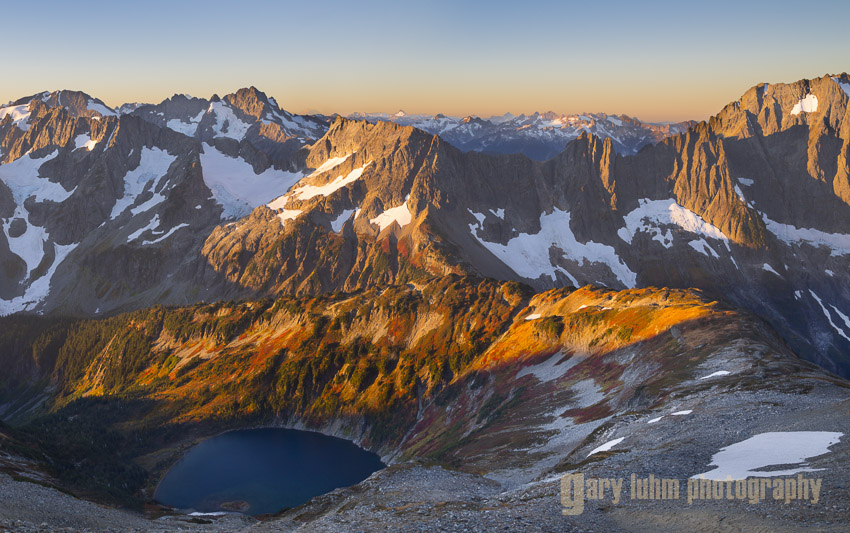
Sahale Arm
In 2012 we had a string of dry, sunny days that extended well into October, so with sun in the forecast we escaped to Sahale Arm in North Cascades National Park. For that you need a permit, free for walk-ons at the Ranger Station in Marblemount. Sahale Arm is reached by way of the popular Cascade Pass, a turnaround point for day hikers but a halfway point to Sahale. In all, we covered seven miles and 4,000 ft elevation gain in four hours, my biggest backpack day of the season.
At our Sahale camp, 7,600 ft, I was hoping for a Milky Way shot in the evening, but though the night was clear, the Puget Sound light pollution from our high perch looking south was too much. Then in the morning we were up to greet the sunrise, but the late-summer trend of cloudless sky didn’t inspire. The best photography began when the morning sun struck the hillsides to paint the golds and reds of fall.
I made a panorama as the sun struck Sahale Arm. This particular image is a crop from the pano that I like more for composition than the full panorama. I probably could have shot this singly at a 24mm angle-of-view, and cropped top and bottom, but that would have meant less pixels for large prints.
The image looks down on Sahale Arm and Doubtful Lake, and across to Magic, Formidable, Mix-up, the Triplets, Cascade Peak and Johannasburg Mountains. Far in the distance, Glacier Peak, Mt. Rainier and the horn of Sloan are in view. Cloudless mornings aren’t a top choice for dramatic scenery, and frankly, August to October, that was the rule in the mountains this year. Still, this view needs little support.
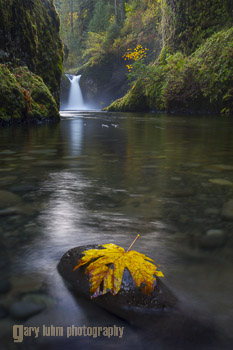
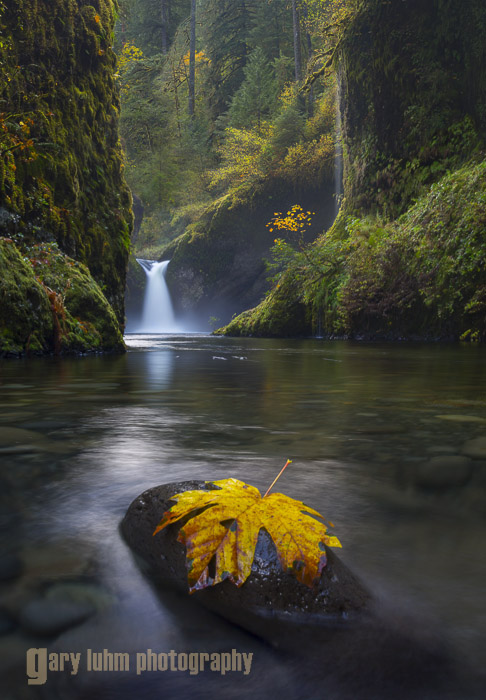
Digitally-manipulated image: Eagle Creek, OR. Canon 5D III.
Punchbowl Falls
On a long daytrip from Kirkand, we hiked Eagle Creek in the Columbia Gorge to Metlako and then Punchbowl Falls (see last month’s tip). I took my drysuit and booties on the hike, and when we arrived at Punchbowl I put them on, crossed the creek and captured some unique views. After I re-crossed, I gathered some Bigleaf Maple leaves that were nicely yellow on the ground, walked out in the water to a view of the falls, and then walked toward it until the water deepened to about mid calf. I found a big, roundish underwater rock that I turned on end to expose its edge, then picked out a promising leaf and placed it on the rock. Looking through the viewfinder, I thought my rock and leaf selection were perfect, though I was still a bit of distance to the falls. My vision here was to shoot at a wide 24mm, with the leaf filling a lot of foreground in the frame. At 24mm, though, I thought the falls looked too small, and the gap between the leaf and falls was too big. I cut the gap a bit by backing up and zooming to 35mm. This made the falls larger, but I still thought I had too much real estate between the leaf and falls. If I backed up further I thought I’d lose the look I liked of the leaf, so I settled for the 35mm framing. I stopped down to f/22 and got the shot. I didn’t focus bracket—my bad. The f/22 image is soft front to back.
Back at the office days later, I studied the image and thought I could improve it. I decided to try squishing that bothersome distance between leaf and falls in Photoshop. I brought the image into Elements 10, selected a rectangular area of water the full width of the image between leaf and falls, and clicked on free transform from the Image menu. Pulling up a handle like a lampshade, I squished the area about 50%. Just like that, the leaf moved closer to the falls, and, I think, transformed a slight awkwardness in composition into a more pleasing one. I then added some forest above the falls with another image that I brought in. The result is suitable for a catalog or magazine cover. And once again, disclosure as a digital composite is paramount.
Gary

Very NICE Images Gary. Very nice presentation and explanation of your travels and process’.
Richard
Thanks for the compliments. Hope you’re out shooting. I’ve been so busy with other things lately (including the website), my cameras are gathering dust.
Gary